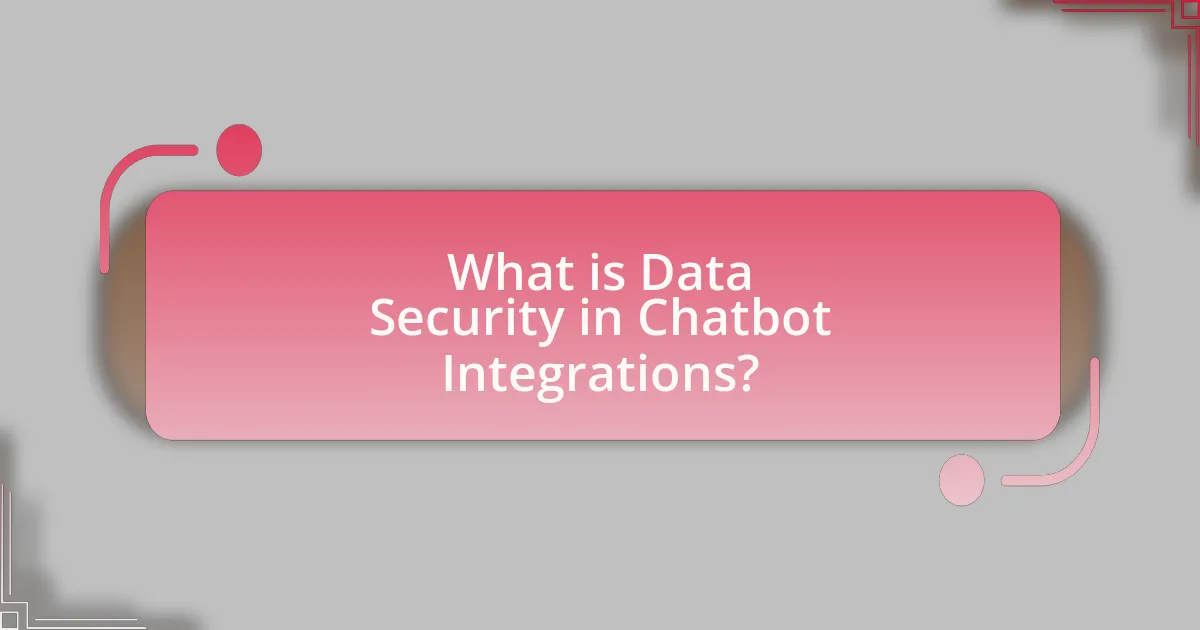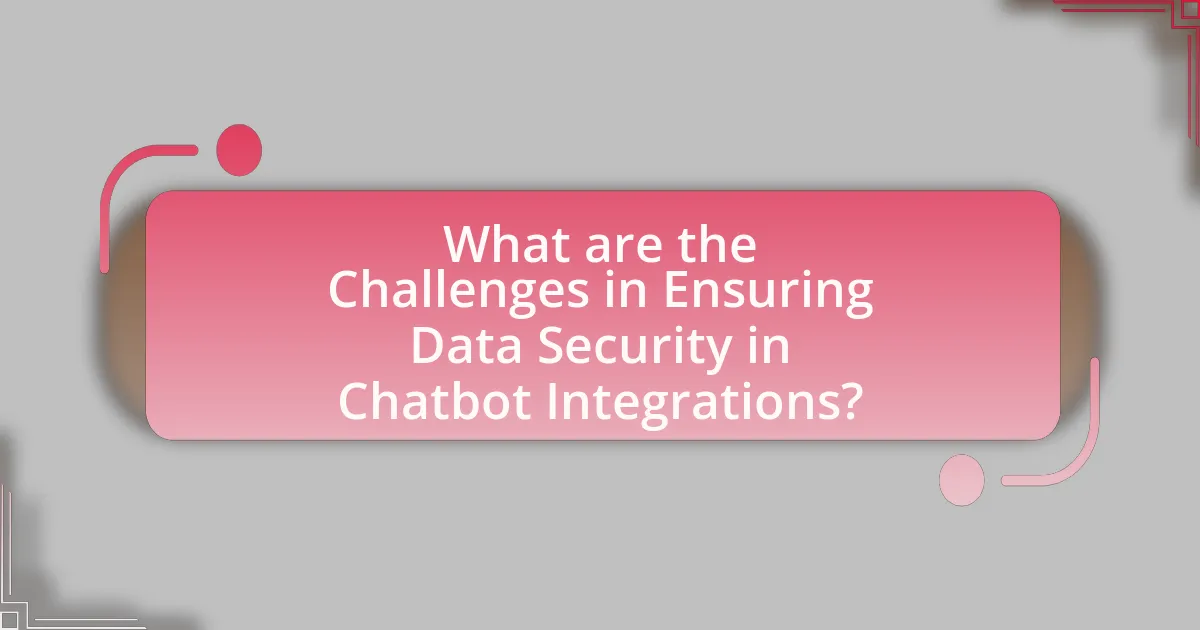Data security in chatbot integrations encompasses the protocols and measures necessary to protect sensitive information exchanged between users and chatbots. This article outlines the importance of data security, highlighting the types of data chatbots handle, the implications of data breaches, and the key principles of confidentiality, integrity, and availability. It also discusses best practices for ensuring data security, including encryption, secure API integrations, and regular security audits, while addressing challenges such as human error and third-party vulnerabilities. Organizations are provided with actionable strategies to enhance chatbot security and maintain user trust in their systems.

What is Data Security in Chatbot Integrations?
Data security in chatbot integrations refers to the measures and protocols implemented to protect sensitive information exchanged between users and chatbots. This includes encryption of data during transmission, secure storage of user data, and compliance with regulations such as GDPR and CCPA. For instance, a study by IBM indicates that organizations can reduce data breach costs by implementing robust security measures, highlighting the importance of data security in maintaining user trust and safeguarding personal information.
Why is Data Security Important for Chatbots?
Data security is crucial for chatbots because they often handle sensitive user information, including personal data and payment details. Ensuring data security protects users from identity theft, fraud, and unauthorized access, which can lead to significant financial and reputational damage for both users and organizations. According to a report by IBM, the average cost of a data breach in 2021 was $4.24 million, highlighting the financial implications of inadequate data security measures. Therefore, implementing robust data security protocols in chatbot integrations is essential to safeguard user information and maintain trust.
What types of data do chatbots typically handle?
Chatbots typically handle structured data, unstructured data, and user interaction data. Structured data includes predefined formats such as names, addresses, and account numbers, which are easily processed and analyzed. Unstructured data encompasses free-text inputs like user queries and feedback, requiring natural language processing for interpretation. User interaction data involves logs of conversations, user preferences, and engagement metrics, which help improve chatbot performance and user experience. These data types are essential for chatbots to function effectively and provide relevant responses.
How can data breaches impact chatbot functionality?
Data breaches can severely compromise chatbot functionality by exposing sensitive user data and undermining trust in the system. When a chatbot experiences a data breach, it may lead to unauthorized access to personal information, which can result in the chatbot being disabled or restricted to prevent further data loss. Additionally, the integrity of the chatbot’s responses may be affected, as compromised data can lead to inaccurate or harmful interactions. For instance, a study by IBM found that the average cost of a data breach is $4.24 million, highlighting the financial and operational impacts that can arise from such incidents.
What are the key principles of Data Security?
The key principles of Data Security are confidentiality, integrity, and availability, often referred to as the CIA triad. Confidentiality ensures that sensitive information is accessed only by authorized individuals, which can be enforced through encryption and access controls. Integrity guarantees that data remains accurate and unaltered during storage and transmission, often achieved through hashing and checksums. Availability ensures that data is accessible to authorized users when needed, which can be supported by redundancy and failover mechanisms. These principles are foundational in protecting data from unauthorized access, corruption, and loss, thereby maintaining trust and compliance in systems, including chatbot integrations.
How does confidentiality apply to chatbot data?
Confidentiality in chatbot data refers to the protection of sensitive information exchanged between users and chatbots. This is crucial because chatbots often handle personal data, such as names, addresses, and financial information, which must be safeguarded to prevent unauthorized access and breaches. Implementing encryption protocols, access controls, and data anonymization techniques ensures that only authorized personnel can access sensitive data, thereby maintaining confidentiality. According to a study by the International Association for Privacy Professionals, 79% of consumers express concern about their data privacy when interacting with chatbots, highlighting the importance of robust confidentiality measures in chatbot integrations.
What role does integrity play in maintaining chatbot data?
Integrity is crucial in maintaining chatbot data as it ensures the accuracy and consistency of the information processed and stored. When chatbot data integrity is upheld, it prevents errors, misinformation, and unauthorized alterations, which can lead to poor user experiences and compromised security. For instance, a study by the International Journal of Information Management highlights that maintaining data integrity reduces the risk of data breaches by ensuring that only authorized users can modify data, thereby enhancing overall security in chatbot integrations.
Why is availability crucial for chatbot services?
Availability is crucial for chatbot services because it ensures that users can access assistance and information at any time, enhancing user satisfaction and engagement. High availability minimizes downtime, which is essential for maintaining trust and reliability in customer interactions. According to a study by Gartner, organizations that prioritize availability in their digital services experience a 20% increase in customer satisfaction, demonstrating the direct correlation between service availability and user experience.

How can Organizations Ensure Data Security in Chatbot Integrations?
Organizations can ensure data security in chatbot integrations by implementing robust encryption protocols, access controls, and regular security audits. Encryption protects data in transit and at rest, making it unreadable to unauthorized users. Access controls limit who can interact with the chatbot and access sensitive information, reducing the risk of data breaches. Regular security audits help identify vulnerabilities and ensure compliance with data protection regulations, such as GDPR or HIPAA, which mandate strict data handling practices. These measures collectively enhance the security posture of chatbot integrations, safeguarding user data effectively.
What security measures should be implemented during chatbot development?
During chatbot development, implementing robust security measures is essential to protect user data and maintain system integrity. Key measures include data encryption, which secures data in transit and at rest, ensuring that sensitive information is not accessible to unauthorized parties. Additionally, employing secure authentication methods, such as OAuth or multi-factor authentication, helps verify user identities and prevent unauthorized access. Regular security audits and vulnerability assessments are crucial for identifying and mitigating potential threats, while adhering to data protection regulations like GDPR ensures compliance and builds user trust. Furthermore, implementing logging and monitoring systems allows for real-time detection of suspicious activities, enhancing overall security posture.
How can encryption protect chatbot data?
Encryption protects chatbot data by converting it into a secure format that is unreadable without a decryption key. This process ensures that sensitive information, such as user interactions and personal data, remains confidential and is safeguarded against unauthorized access. For instance, when data is transmitted between a chatbot and a server, encryption protocols like TLS (Transport Layer Security) can be employed to secure the communication channel, making it difficult for attackers to intercept and decipher the information. According to a report by the Ponemon Institute, organizations that implement encryption experience a 50% reduction in the risk of data breaches, highlighting the effectiveness of encryption in protecting sensitive data.
What are the best practices for secure API integrations?
The best practices for secure API integrations include implementing authentication and authorization mechanisms, using HTTPS for secure communication, validating input data, and regularly updating and patching APIs. Authentication ensures that only authorized users can access the API, while authorization controls what actions they can perform. HTTPS encrypts data in transit, protecting it from eavesdropping. Input validation prevents injection attacks by ensuring that only expected data formats are accepted. Regular updates and patches address vulnerabilities, reducing the risk of exploitation. These practices collectively enhance the security posture of API integrations, safeguarding sensitive data in chatbot applications.
How can organizations monitor and respond to security threats?
Organizations can monitor and respond to security threats by implementing a combination of real-time threat detection systems, regular security audits, and incident response plans. Real-time threat detection systems utilize advanced analytics and machine learning to identify anomalies in network traffic, allowing organizations to detect potential breaches as they occur. Regular security audits help identify vulnerabilities in systems and processes, ensuring that security measures are up to date. Incident response plans provide a structured approach for organizations to follow when a security threat is detected, enabling them to mitigate damage quickly and effectively. According to a report by the Ponemon Institute, organizations with an incident response plan can reduce the cost of a data breach by an average of $14 per compromised record, highlighting the importance of preparedness in responding to security threats.
What tools are available for monitoring chatbot security?
Tools available for monitoring chatbot security include security information and event management (SIEM) systems, intrusion detection systems (IDS), and chatbot-specific monitoring platforms. SIEM systems, such as Splunk and IBM QRadar, aggregate and analyze security data from various sources, providing real-time alerts on suspicious activities. Intrusion detection systems, like Snort, monitor network traffic for malicious activities or policy violations. Additionally, platforms like Botanalytics and Dashbot offer insights into chatbot interactions and can flag unusual patterns that may indicate security issues. These tools collectively enhance the security posture of chatbot integrations by enabling proactive monitoring and response to potential threats.
How should organizations respond to a data breach involving chatbots?
Organizations should immediately assess the extent of the data breach involving chatbots by conducting a thorough investigation. This involves identifying the type of data compromised, the number of affected users, and the vulnerabilities exploited. Following the assessment, organizations must notify affected users and relevant authorities, as mandated by data protection regulations such as GDPR, which requires notification within 72 hours of becoming aware of a breach.
Additionally, organizations should implement remedial measures to secure the chatbot system, such as patching vulnerabilities, enhancing encryption, and reviewing access controls. They should also communicate transparently with stakeholders about the breach and the steps taken to mitigate future risks. According to a report by IBM, the average cost of a data breach in 2023 was $4.45 million, highlighting the importance of a swift and effective response to minimize financial and reputational damage.

What are the Challenges in Ensuring Data Security in Chatbot Integrations?
Ensuring data security in chatbot integrations faces several challenges, including data privacy concerns, inadequate encryption, and vulnerability to cyberattacks. Data privacy is critical as chatbots often handle sensitive user information, and any breach can lead to significant legal and reputational repercussions. Inadequate encryption methods can expose data during transmission, making it susceptible to interception. Furthermore, chatbots can be targeted by cyberattacks, such as phishing or denial-of-service attacks, which can compromise user data and disrupt services. According to a report by IBM, the average cost of a data breach is $4.24 million, highlighting the financial implications of failing to secure data effectively in chatbot systems.
What common vulnerabilities exist in chatbot systems?
Common vulnerabilities in chatbot systems include inadequate input validation, which can lead to injection attacks, and insufficient authentication mechanisms, making them susceptible to unauthorized access. For instance, a lack of proper input sanitization can allow attackers to execute SQL injection, compromising the underlying database. Additionally, chatbots often store sensitive user data without proper encryption, exposing it to data breaches. According to a report by the Ponemon Institute, 60% of organizations experienced a data breach due to inadequate security measures in their chatbot systems. These vulnerabilities highlight the critical need for robust security protocols in chatbot integrations to protect user data effectively.
How can human error contribute to security risks?
Human error significantly contributes to security risks by introducing vulnerabilities through actions such as misconfigurations, weak password practices, and unintentional data sharing. For instance, a study by IBM found that human error accounts for approximately 95% of cybersecurity breaches, highlighting the critical impact of individual actions on overall security. Misconfigured settings in chatbot integrations can lead to unauthorized access, while weak passwords can be easily exploited by attackers. Additionally, employees may inadvertently share sensitive information during interactions, further compromising data security.
What are the implications of third-party integrations on security?
Third-party integrations can significantly compromise security by introducing vulnerabilities that may not be present in the primary system. These integrations often require access to sensitive data, which can be exploited if the third-party service lacks robust security measures. For instance, a study by the Ponemon Institute found that 59% of organizations experienced a data breach due to third-party vendors, highlighting the risks associated with inadequate security protocols. Additionally, third-party services may not adhere to the same compliance standards, increasing the likelihood of data exposure. Therefore, organizations must conduct thorough security assessments and implement stringent access controls when integrating third-party services to mitigate these risks.
How can organizations overcome these challenges?
Organizations can overcome challenges in ensuring data security in chatbot integrations by implementing robust encryption protocols and regular security audits. Encryption protects sensitive data during transmission and storage, making it inaccessible to unauthorized users. Regular security audits help identify vulnerabilities and ensure compliance with data protection regulations, such as GDPR, which mandates strict data handling practices. Additionally, training employees on security best practices enhances awareness and reduces the risk of human error, a common factor in data breaches.
What training should be provided to staff regarding chatbot security?
Staff should receive training on identifying and mitigating security risks associated with chatbots. This training should cover topics such as data encryption, secure authentication methods, and recognizing phishing attempts that target chatbot interactions. Additionally, staff should be educated on compliance with data protection regulations, such as GDPR and CCPA, which mandate strict guidelines for handling user data. Regular updates on emerging threats and best practices in cybersecurity should also be included to ensure staff remain vigilant and informed.
How can regular audits improve chatbot security measures?
Regular audits can significantly enhance chatbot security measures by identifying vulnerabilities and ensuring compliance with security protocols. These audits systematically evaluate the chatbot’s performance, data handling, and interaction logs, allowing organizations to detect potential security breaches or weaknesses in real-time. For instance, a study by the Ponemon Institute found that organizations conducting regular security audits experienced 30% fewer data breaches compared to those that did not. This proactive approach not only mitigates risks but also fosters a culture of continuous improvement in security practices, ultimately safeguarding user data and maintaining trust.
What are the best practices for maintaining Data Security in Chatbot Integrations?
The best practices for maintaining data security in chatbot integrations include implementing end-to-end encryption, ensuring secure API connections, and regularly updating software. End-to-end encryption protects data during transmission, making it unreadable to unauthorized parties. Secure API connections prevent data breaches by using authentication protocols like OAuth 2.0. Regular software updates address vulnerabilities, as evidenced by a 2021 report from the Cybersecurity and Infrastructure Security Agency, which highlighted that 85% of successful cyberattacks exploit known vulnerabilities in outdated software. Additionally, conducting regular security audits and user training enhances awareness and compliance with security protocols.
How can organizations implement a security-first approach in chatbot design?
Organizations can implement a security-first approach in chatbot design by integrating robust encryption protocols, ensuring data privacy, and conducting regular security audits. By utilizing end-to-end encryption, organizations protect user data from unauthorized access during transmission. Additionally, implementing strict access controls and user authentication mechanisms safeguards sensitive information stored within the chatbot system. Regular security audits help identify vulnerabilities and ensure compliance with data protection regulations, such as GDPR, which mandates that organizations take appropriate measures to protect personal data. These practices collectively enhance the security posture of chatbots, mitigating risks associated with data breaches and unauthorized access.
What ongoing assessments are necessary for chatbot security?
Ongoing assessments necessary for chatbot security include regular vulnerability scanning, penetration testing, and compliance audits. Vulnerability scanning identifies potential security weaknesses in the chatbot’s code and infrastructure, while penetration testing simulates attacks to evaluate the chatbot’s defenses. Compliance audits ensure adherence to data protection regulations, such as GDPR or CCPA, which are critical for maintaining user trust and legal compliance. These assessments should be conducted at least quarterly to adapt to evolving threats and ensure robust security measures are in place.










